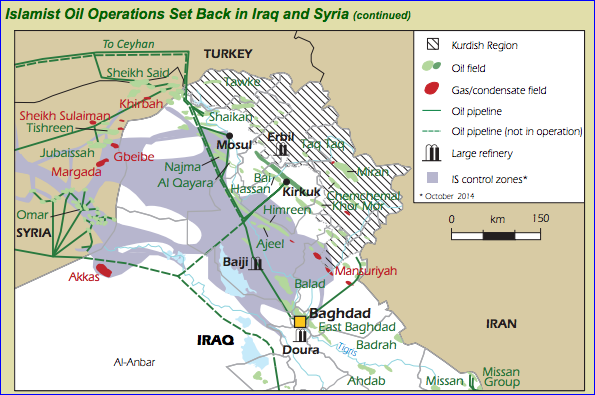By Matthew Philips – BUSINESSWEEK – 16 Oct 2014

Islamic State’s oil empire is slowly being dismantled (OECD/IEA, 2014 Oil Market Report, Oct. 2014).
It’s been a month since President Obama announced that the U.S. would engage in a sustained campaign of airstrikes against Islamic State, the militant Sunni rebellion in Syria and Iraq. The idea was to bomb Islamic State into nonexistence, which has proved difficult. Not only is the movement well-armed, battle-hardened, and deeply entrenched in much of Syria and northern Iraq, it’s also very well-financed, thanks to oil wells and refineries it’s been able to capture. By late June, Islamic State was raising as much as $2 million a day refining and smuggling oil, making it one of history’s wealthiest terrorist groups.
Though the airstrikes have failed to keep Islamic State from advancing in the field, they have apparently succeeded in dismantling its sophisticated oil network, reducing the movement’s ability to make gasoline and diesel for its tanks and trucks and cutting off a vital source of funding. A report from the International Energy Agency in Paris has just estimated that Islamic State controls only about 20,000 barrels of daily oil production, down from about 70,000 as of August. Most of it remains in Iraq.
In early August, Islamic State controlled sections of Syria and Iraq that together are about the size of Wyoming. At that point, its territory included seven oil fields and a refinery in northern Iraq, as well as six of the 10 oil fields in eastern Syria. Although the movement was able to produce only about half the potential output under its control, it had no problem tapping the region’s well-established oil smuggling network.
Most of the group’s oil flows through local middlemen and is paid for almost entirely in cash, making transactions extremely difficult to track and shut down. This has insulated Islamic State from traditional methods the West has used to dry up terrorist funds in the past, such as international banking sanctions and anti-money laundering laws.
A straight-up bombing campaign does seem to be doing a lot of that work. According to the IEA report, U.S.-led sorties over northern Iraq and Syria are “frustrating the jihadists’ ability to operate oil fields and refineries.” At its peak, most of the oil smuggled from Iraq was loaded from the Ajeel oil field near Tikrit on tanker trucks and routed toward Kurdistan. The IEA, citing Iraqi oil industry sources, estimates that Islamic State was loading about 120 tanker trucks with about 20,000 barrels a day from Ajeel. Sustained airstrikes, including ones targeting convoys, have cut that traffic to about 10 trucks a day, or about 2,000 barrels, according to the IEA’s report.
In Syria, the IEA estimates that Islamic State’s oil output is down to about 10,000 barrels a day. Airstrikes by the U.S., the Saudis, and the UAE have wiped out “dozens of teapot refineries” in Syria, depriving the movement’s war machine of a key source of gasoline. Turkey and the Kurds have also cracked down on its smuggling operation. In late September, the Kurds reportedly seized four militant tanker trucks from the Ajeel field and detained the drivers.
There is still a lot of work to do. The Islamists retain control of Syria’s largest oil field, the Omar field in the Deir Az-Zour region of the country. The squeeze on finances has made Islamic State even more desperate to control oil fields and refineries. Its fighters have turned Iraq’s largest refinery into a battleground–forcing it off-line and sharply reducing output. With most of its refining capacity in Syria destroyed, Islamic State might go after two big refineries, closer to Lebanon in the west of Syria, that are under the Assad government’s control, opening up a much broader two-front war and potentially limiting the movement’s ability to wage war to the east, in Iraq.

Aucun commentaire:
Enregistrer un commentaire